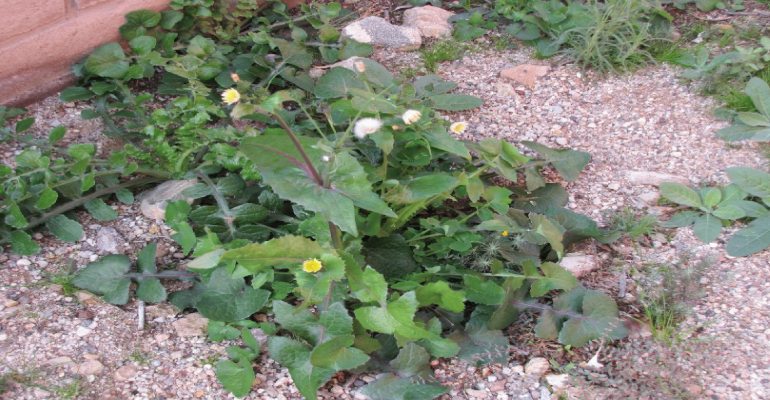
A new weed has sprouted in my yard. With the help of a botanist at the Arizona-Sonora Desert Museum, this new plant is identified as the genus Sonchus, commonly called sowthistle. Sowthistle species occur in temperate zones worldwide. Arizona has two species, Common Sowthistle (Sonchus oleraceus), the one in my yard, and Spiny Sowthistle (Sonchus asper). These plants are related to dandelions and are members of the sunflower family. For an idea of the plant size, the large leaf in the center of the photo is 10 inches long.
The name “Sowthistle” refers to the fact that pigs are especially fond of the leaves and stems. So are rabbits. This plant is also called “hare thistle” or “hare lettuce” in some parts of the world.
The leaves are also used by humans, especially in Chinese cooking. The leaves can be eaten as a salad green or cooked and used like spinach. Blanching removes a slightly bitter taste. (Source) I have not tried it.
“This plant has powerful medicinal properties, with some toxicity, but at the same time it is also highly nutritious. It contains, per 100g, around 30mg of vitamin C, 1500 mg of calcium and 45 mg of iIron. The dried leaves contain up to 28g of protein per 100g – a great nutritional supplement. Use only young leaves as edibles, raw, in salads or cooked, as spinach.” (Source)
Medicinal uses are the same as for dandelions:
“In the past, dandelion roots and leaves were used to treat liver problems. Native Americans also boiled dandelion in water and took it to treat kidney disease, swelling, skin problems, heartburn, and upset stomach. In traditional Chinese medicine (TCM), dandelion has been used to treat stomach problems, appendicitis, and breast problems, such as inflammation or lack of milk flow. In Europe, dandelion was used in remedies for fever, boils, eye problems, diabetes, and diarrhea.” (See more from the University of Maryland Medical Center.)
Sow thistles exude a milky latex when any part of the plant is cut or damaged, and it is from this fact that the plants obtained the common name, “sow thistle”, as they were fed to lactating sows in the belief that milk production would increase. Sow thistles are known as “milk thistles” in some regions, although true milk thistles belong to the genus Silybum. (Source)
The yellow flowers are about 1.25 inches in diameter and attract bees, flies, and aphids. The flowers turn into dandelion-like tufts and the seeds go floating off in the wind.
Common Sowthistle is classified as an annual herb and can grow up to four feet high. Other species of Sonchus are perennials.
Have you seen this plant in your yard?
Some other interesting weeds from my yard:
Note to readers:
- Index with links to all my ADI articles: http://wp.me/P3SUNp-1pi
- My comprehensive 28-page essay on climate change: http://wp.me/P3SUNp-1bq
- A shorter ADI version is at https://arizonadailyindependent.com/2013/08/01/climate-change-in-perspective/
